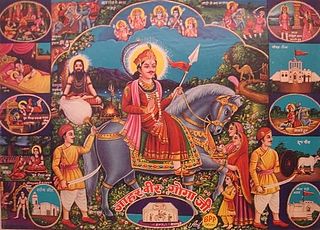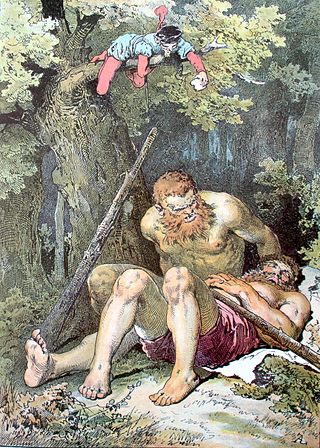
A fairy tale is a short story that belongs to the folklore genre. Such stories typically feature magic, enchantments, and mythical or fanciful beings. In most cultures, there is no clear line separating myth from folk or fairy tale; all these together form the literature of preliterate societies. Fairy tales may be distinguished from other folk narratives such as legends and explicit moral tales, including beast fables. Prevalent elements include dragons, dwarfs, elves, fairies, giants, gnomes, goblins, griffins, merfolk, monsters, monarchy, pixies, talking animals, trolls, unicorns, witches, wizards, magic, and enchantments.
Japanese folktales are an important cultural aspect of Japan. In commonplace usage, they signify a certain set of well-known classic tales, with a vague distinction of whether they fit the rigorous definition of "folktale" or not among various types of folklore. The admixed impostors are literate written pieces, dating back to the Muromachi period or even earlier times in the Middle Ages. These would not normally qualify for the English description "folktales".

English folklore consists of the myths and legends of England, including the region's mythical creatures, traditional recipes, urban legends, proverbs, superstitions, dance, balladry, and folktales that have been passed down through generations, reflecting the cultural heritage of the country. This body of folklore includes a diverse array of characters, such as heroic figures like Beowulf or Robin Hood, legendary kings like Arthur, and mythical creatures like the Green Man and Black Shuck. These tales and traditions have been shaped by the historical experiences of the English people, influenced by the various cultures that have settled in England over centuries, including Celtic, Roman, Anglo-Saxon, Norse, and Norman elements.
Irish folklore refers to the folktales, balladry, music, dance and mythology of Ireland. It is the study and appreciation of how people lived.

Heer Ranjha is a traditional Punjabi folk tragedy with many historic poetic narrations; with the first one penned by Damodar Gulati in 1600s, on the preexisting oral legend; and the most famous one, Heer, written by Waris Shah in 1766, in the form of an epic. Set in Takht Hazara and Tilla Jogian, it follows the story of love, forced separation, and eventual simultaneous demise of two youths in the Punjabi countryside.
The Aarne–Thompson–Uther Index is a catalogue of folktale types used in folklore studies. The ATU index is the product of a series of revisions and expansions by an international group of scholars: Originally published in German by Finnish folklorist Antti Aarne (1910), the index was translated into English, revised, and expanded by American folklorist Stith Thompson, and later further revised and expanded by German folklorist Hans-Jörg Uther (2004). The ATU index is an essential tool for folklorists, used along with the Thompson (1932)Motif-Index of Folk-Literature.

Hoshiarpur district is a district of Punjab state in northern India. Hoshiarpur, one of the oldest districts of Punjab, is located in the North-east part of the Punjab state and shares common boundaries with Gurdaspur district in the north-west, Jalandhar district and Kapurthala district in south-west, Kangra district and Una district of Himachal Pradesh in the north-east. Hoshiarpur district comprises 4 sub-divisions, 10 community development blocks, 9 urban local bodies and 1417 villages. The district has an area of 3365 km2. and a population of 1,586,625 persons as per census 2011.

Gogaji, also known as Gogaji Jaharveer Maharaj or Jaharveer Chauhan, is a folk Hindu deity in northern India. He is worshipped in the northern states of India especially in Rajasthan, Himachal Pradesh, Haryana, Uttarakhand, Punjab region, Uttar Pradesh, Jammu and Gujarat. He is a warrior-hero of the region, venerated as a saint and a protector against snake bites. Although there are references to him in the folklore of Rajasthan, little historical knowledge of Gugga exists other than that he ruled the small kingdom of Dadrewa and was a contemporary of Prithviraj Chauhan.

Pakistani folklore encompasses the mythology, poetry, songs, dances and puppetry from Pakistan's various ethnic groups.
Raja Sálbán was a legendary Indian monarch who is said to have founded the city and the Sialkot Fort in Punjab. According to Punjabi folklore, he was father of Puran Bhagat and Raja Rasalu, the protagonist of the Adventures of Raja Rasalu.

Sassui Punnhun or Sassi Punnu is a traditional Sindhi, Balochi, and Punjabi tragic folktale. Set in Sindh and Makran, the tragedy follows the story of a faithful lover who endures many difficulties while seeking her beloved husband who was separated from her by rivals.

"The Brave Little Tailor" or "The Valiant Little Tailor" or "The Gallant Tailor" is a German fairy tale collected by the Brothers Grimm. "The Brave Little Tailor" is a story of Aarne–Thompson Type 1640, with individual episodes classified in other story types.
Lahnda, also known as Lahndi or Western Punjabi, is a group of north-western Indo-Aryan language varieties spoken in parts of Pakistan and India. It is defined in the ISO 639 standard as a "macrolanguage" or as a "series of dialects" by other authors. Its validity as a genetic grouping is not certain. The terms "Lahnda" and "Western Punjabi" are exonyms employed by linguists, and are not used by the speakers themselves.
Keigo Seki was a Japanese folklorist. He joined a group under Yanagita Kunio, but often came to different conclusions regarding the same folktales. Along with collecting and compiling folktales, Seki also arranged them into a series of categories.

Puran Bhagat is a mythical prince of Sialkot from Punjabi folklore. According to the story, he was son of King Salban of Sialkot and an elder brother of prince Rasalu.
The Vār or Vaar, in Punjabi poetry, is a heroic ode or ballad which generally narrates legend such as stories of Punjabi folk heroes or a historical event. Examples include the feats of Dulla Bhatti and Raja Rasalu, Amir Khusrau's Vaar for Ghazi Malik who took the throne of Delhi in 1320, the Vaar of Shaikh Khokhar, and Najabat's Nadar Shah Di Var which describes the invasion of India by Nadir Shah in 1739. The Var has also been used to evoke the mood of devotion or sacrifice, as in Guru Gobind Singh's Chandi di Var, or to narrate the mystical experience of a Pir, Bhagat or Guru.

Punjabi folk music is the traditional music on the traditional musical instruments of the Punjab region of the Indian subcontinent. There is a great repertoire of music from the time of birth through the different stages of joy and sorrow till death. The folk music invokes the traditions as well as the hardworking nature, bravery and many more things that the people of Punjab get from its gateway-to-India geographical location. Due to the large area with many sub-regions, the folk music has minor lingual differences but invokes the same feelings. The sub-regions, Malwa, Doaba, Majha, have numerous folk songs. Punjabi dance OP Bhangra music which is a genre of Punjabi modern music invented in Britain by the Punjabi diaspora.
Sohinder Singh Wanjara Bedi (1924-2001) was a Punjabi folklorist and a British Indian born in Sialkot, a city now part of Pakistan.
Folk practices prevalent in Punjab incorporate local mysticism and refers to the beliefs and practices strictly indigenous to the Punjabi people, of the Punjab region including ancestral worship, veneration of saints, and local festivals. There are many shrines in Punjab which represent the folk religion of the Punjab region which is a discourse between different organised religions. These shrines represent inter-communal dialogue and a distinct form of cultural practice of saint veneration.

Raja Rasalu is a fictional character and protagonist of the Adventures of Raja Rasalu, a Punjabi folktale. According to the story, he is son of Raja Sálbán, the king of Sialkot, and a younger brother of Puran Bhagat.















